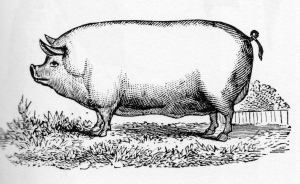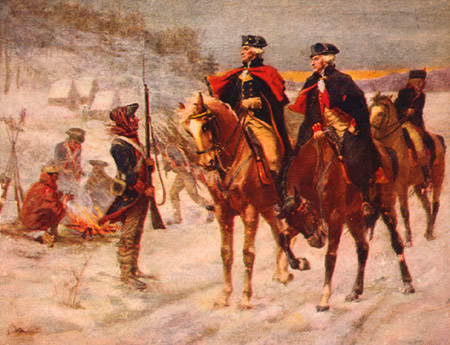The curious case of the proliferating pepperpot & its strange excursion north --or not.
Pepperpot appears in different guises as a local specialty all over the Caribbean basin and, an apparent outlier among North American cities, also in Philadelphia.
Jessica B. Harris, however, does not consider Philadelphia anomalous at all; she claims it as a northern Creole city because Africans slave and free (but mostly slave) lived there during the seventeenth and eighteenth centuries. To her immense credit, Harris tries hard not to fall into the trap of racial chauvinism that more strident writers inhabit. She succeeds, despite some politically correct and suitably offended tilting at the racist windmills of the nineteenth and twentieth century American south. Nonetheless her tortured attempt in Beyond Gumbo to define the term as both ethnically and culinarily inclusive leaves us with barely any definition at all.

Philadelphia – a Creole city?
To Harris, ‘Creole’ means nothing more distinctive than ‘blending’ in the context of all the peoples, cultures and foods of the Atlantic basin. At one point she would appear to limit the ambit of her analysis to its southern rim, but then up crops Philadelphia.
It would appear that for Harris, Philadelphia is a Creole city primarily because of pepperpot. She explains that over the years she has become “more convinced of the cultural connections between Philadelphia and the Caribbean. Nowhere is the question more apparent than in Philadelphia pepperpot soup.” (Beyond Gumbo 95) At this point the thoughtful reader might be forgiven for assuming that Harris never has actually seen Philadelphia or experienced its culture, but we may infer from Beyond Gumbo that such is not the case; she has a friend there, an “adopted culinary cousin.” (Beyond Gumbo 95)
It remains difficult to discern any Creole cast to the culture of Philadelphia that Harris or anyone else actually has identified except for pepperpot, however, so what of that?
While Caribbean pepperpots display considerable variation, they also share common attributes. The greatest gulf in style divides pepperpots derived from the Guyanese and Jamaican models until, that is, we consider Philadelphia, and after addressing the evidence it becomes hard not to conclude that the Caribbean and Philadelphian strains of pepperpot share nothing but the name.

Even the merriest and best natured cultural chauvinists, like Austin Clarke (a cheerful Champion of Creole Barbados) concede that Caribbean pepperpot got its start among the pork knockers of Guyana via the Amerindians there. Pork knockers were, according to Clarke, “daring men who roamed the bush looking for diamonds and silver” during the early days of exploration. “They got their name from the pieces ‘o pork they uses to eat with bread baked hard to last. The pork was ‘knocking their stomachs’--filling a hole.” (Pig Tails 175)
Austin considers pepperpot “a dish of great national-cultural significance, the only food that is really Guyanese.” (Pig Tails 183) He and everyone else who consider the only Guyanese food concur that the essential ingredient for an authentic pepperpot is cassareep. Bottled cassareep is available from grocers in West Indian neighborhoods and from several suppliers (unfortunately with varying degrees of reliability) online. Cassareep can be difficult to find but is easy to make, as Elisabeth Lambert Ortiz explains:
“It is made by grating raw cassava and squeezing out the juice, which is then boiled down. When it begins to turn brown, it is flavored with salt, brown sugar, cinnamon and cloves and the boiling continued until the cassareep has the consistency of a thick, dark brown syrup.” (Ortiz 160)
Once you have some cassareep, assembling the pepperpot is equally easy. Clarke’s ‘recipe’ displays no proportions but lots of common sense. He dumps chuck ribs or corned beef, salted pigtails and chunks of pork shoulder with its bone and skin into a pot, seasons the stew with lemon, a whole hot chili, cloves, thyme, Demerara (the old name for Guyana) sugar and salt, “as much as you can bear.” (Pig Tails 185-87) He boils everything up with four ounces of bottled cassareep and serves the pepperpot with any number of options, but “[j]ust choose one or two.” The choices include green bananas, plantain, rice, “hard-dough bread” available from West Indian grocers and cassava hats made from the ‘trash’ left after squeezing the juice of the cassava to make cassareep (waste not… ). (Pig Tails 187-89)

Harris adds oxtail and cowheel to the mix of meats but omits the characteristically Barbadian pigtails; she also chooses lime juice, lots of it, over the smear of lemon that Clarke favors. Ortiz has an even simpler version than Clarke: Oxtail, cowheel, corned beef and chunks of beef or pork join the proverbial chicken in a pot with cassareep and hot chilies to simmer “until the meats and the chicken are tender and the sauce quite thick.” (Ortiz 161)
Jamaican pepperpot is not so thick: In fact it is a soup laced with greens and any number of other things, in so many permutations that it is possible to build two authentic Jamaican pepperpots without a common ingredient. Most but not all of them include preserved meat, although as in Guyana the type varies. Some writers insist that in Jamaica it cannot be pepperpot without callaloo; others never mention the green. Recipes may include coconut, okra, salt pork and shrimp, alone or in various combinations, while the oldest Caribbean version in the Editor’s collection lacks anything green and is the only one to add hard boiled egg, an ancient English touch. Otherwise, however, this last Jamaican version looks positively Guyanese:
“Get an earthen vessel. To every quart of cold water, add three tablespoonfuls of the pure cassaripe [sic] with salt to taste and a handful of bird peppers. If these cannot be had, use some cayenne. Cut the meat into small pieces after being well cooked, and put into the pot: boil well for half an hour. Any sort of meat may be used, all mixed in it, and hard boiled eggs are an improvement. It should be warmed every day, and something added each day.” (Sullivan 6)
As Mrs. Glasse or Eliza Acton would have said, a good receipt.
The ‘addition of something every day’ is no throwaway line, for a pepperpot built on cassareep is the pot au feu of the tropics. It turns out that cassareep “keeps indefinitely” (Ortiz 160) and acts as a preservative too, one of the reasons that the Amerindians and itinerant pork knockers favored its use.
As long as a dose of the cassareep joins ‘something each day’ in the pepperpot, and even if it sometimes does not, the cassareep “keeps it lasting and lasting for days without going bad.” (Pig Tails 177) Rumors of perpetual pepperpots abound. Harris writes that a woman in Granada “was reputed to have a pepperpot that was kept in this manner for over a century.” (Beyond Gumbo 226)
When he visited Georgetown in Guyana, a woman told him that at one hotel a pepperpot was simmering away in the same pot after ten years but he never found this or any other “everlasting pepperpot” and therefore concluded that the “fractious” and unreliable Guyanese “would tell you certain lies about pepperpot and call them myths.” (Pig Tails 178-79, 183)
Thousands of miles up the mainland it is possible to encounter a number of other myths involving a pepperot from, or possibly not really from, Philadelphia. The classic Philadelphia rendition relies unequivocally on an ingredient that Harris does not even include as an index entry in either of her books dedicated to Caribbean foodways: Tripe. As James Beard reasoned, “there is a very good chance that the soup is of French or English origin. Both cuisines are partial to tripe.” (Beard) James Villas concurs, but in a depressingly disappointing way. Ignoring Beard’s reference to the possibility of an English antecedent, Villas incorrectly claims that “Beard always said it was essentially French--and I agree.” (Villas 190)
Villas compounds our disappointment in him by providing ‘his own’ recipe lifted straight and without attribution from Mrs. Rorer’s Philadelphia Cook Book of 1886. Plagiarism may be a time honored practice when it comes to food writing, but by now any food historian who adopts an authoritative voice, like Villas, ought to disclose his sources. At this juncture we therefore should not much care whether he agrees with Beard or anyone else.
Other sources trace Philadelphia pepperpot variously to the Dutch, to Germans and to Valley Forge. The Dutch influence would appear more apparent than real; nobody provides a citation for their claim to the dish.
According to Leonard Louis Levinson’s discussion of the earliest ‘immigrant’ influences on American food in The American Heritage Cookbook, “Philadelphia welcomed many Germans, who introduced sauerbraten and sauerkraut and helped create pepper pot soup and scrapple.” (American Heritage 238) It is hard, however, to find much common ground between Germany and the pepperpot other than to note with obvious irrelevance that sauerbraten and sauerkraut, like corned beef and salted pigtail, are examples of pickled foods.
The only other reference to Philadelphia (or any other) pepperpot in American Heritage appears as the introduction to a recipe for it. This entry provides an almost certainly apocryphal, not to say ridiculous, link to revolution:
 Washington and some French guy (oh, Lafayette) at Valley Forge
Washington and some French guy (oh, Lafayette) at Valley Forge
“During the relentlessly harsh winter of 1777-78, morale was low at Valley Forge, and desertions frequent. According to legend, Washington ordered a good meal to cheer his troops one night--only to be told by his harried cook that there was nothing but tripe, some peppercorns and useless scraps. Still, an order was an order, and the cook improvised a soup which he called, ex post facto, Philadelphia (in honor of his home town) Pepper pot.” (American Heritage 424)
The recipe itself is a good one, based on veal knuckle, tripe and temperate seasonings. It looks like the other Philadelphia based pepperpots, including the ones from Mrs. Rorer and Anna Wetherill Reed, and unlike any of the Caribbean versions.
To be fair to the Creole chauvinist, Walter Staib also considers ‘West Indies Pepper Pot Soup’ “the grandfather to the traditional Philadelphia Pepper Pot Soup--and to my taste, the superior recipe of the two.” (City Tavern 44) There is more; in language that sounds like Harris, Staib adds that his is
“an authentic West Indian recipe that is more than 250 years old. Back then, English ships traveled through the islands transporting slaves as well as exotic foodstuffs, so that West Indian cookery found its way into the very fabric of Philadelphia life.” (City Tavern 44)
Staib is no slouch, but from the evidence of his writing is a better businessman than historian. He operates the City Tavern in Philadelphia, and helped to found something called the Caribbean Culinary Federation which, however, turns out to be a marketing arm of the Caribbean Hotel Association, a trade group and tourism promoter. CCF itself apparently does not operate a website or address the history of food, but does run promotional events frequently keynoted by… Jessica B. Harris.

The interest of CCF, it seems, is more hucksterism than history, and Staib’s linkage of Philadelphia to the Caribbean looks a lot like a nonstarter. He provides no basis for the assertion and, as it happens, his recipe for pepperpot has no connection to the city. Instead it is “from Miss Betty, a great Jamaican lady of undetermined age” who lives in Jamaica. (City Tavern 44) None of this should take anything away from Miss Betty or her recipe, which is both excellent and accessible.
The West Indian strain of pepperpot does make it as far north as longitude 32, to Bermuda, where cooks typically add much less (brown) sugar than their counterparts further south, only a tablespoon, but they too like their cassareep (with an added ending ‘e’), chicken, oxtail and pigs feet simmered with searing bird peppers. One Bermudian recipe instructs the maker of pepperpot to “cook for three days before using.” The same author adds that “[y]ou can put in coked beef or even fresh pork, but never put in vegetables or fish.” (de Marcy et al. 12)
Before leaving colder climes, we should note that in Beyond Gumbo, Harris herself provides a recipe for a “pepper pot soup with pumpkin and seafood” from her Philadelphian ‘culinary cousin.’ This bizarre version based on lobster, scallops, turtle, fish fumet and heavy cream (no cowfoot, no cassareep, no oxtail or salt meats or tripe) may be as good as she claims, but it manifestly is not a pepperpot.
Best to stick with Beard, then, if you choose your own Philadelphia creation myth and ascribe it to one of the great antagonists facing off across the English Channel, or disregard him in favor of the Germans (Staib is German) or Dutch….
Recipes for cassareep (with measurements), pepperpot and sauerbraten appear in the practical.
Note:
- Austin Clarke considers pea soup aphrodisiac, and green bananas too, “suitable for men mainly. And it more cheaper and safer than Viagra. Now you know!” (Pig Tails 188)
Sources:
James Beard, James Beard’s American Cookery (New York 1972); accessed at www.books.google.com by entering the search term ‘pepper pot James Beard.’
Austin Clarke, Pig Tails ‘n Breadfruit: A Culinary Memoir
(New York 1999)
Mrs. Hubert de Marcy et al., Bermudian Cookery
(Hamilton, Bermuda, 1981)
Jessica B. Harris,
Beyond Gumbo: Creole Fusion Food from the Atlantic Rim
(New York 2003)
Sky Juice and Flying Fish: Traditional Caribbean Cooking
(New York 1991)
Richard M. Ketchum (ed.), The American Heritage Cookbook
(New York 1964)
Elisabeth Lambert Ortiz, The Complete Book of Caribbean Cooking (New York 1973)
Anna Wetherill Reed, The Philadelphia Cook Book of Town and Country (New York 1963)
Sarah Tyson Rorer, Mrs. Rorer’s Philadelphia Cook Book (Philadelphia 1886)
Caroline Sullivan, A Collection of 19th Century Jamaican Cookery and Herbal Recipes
(Kingston, Jamaica 1893; facsimile reprint 1990)
James Villas, Stews, Bogs & Burgoos (New York 1997)

